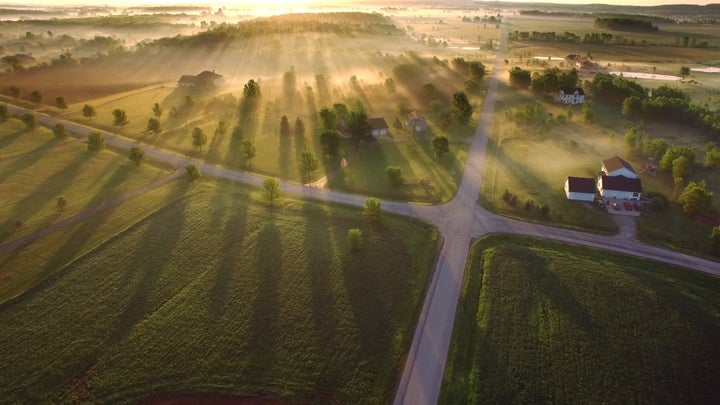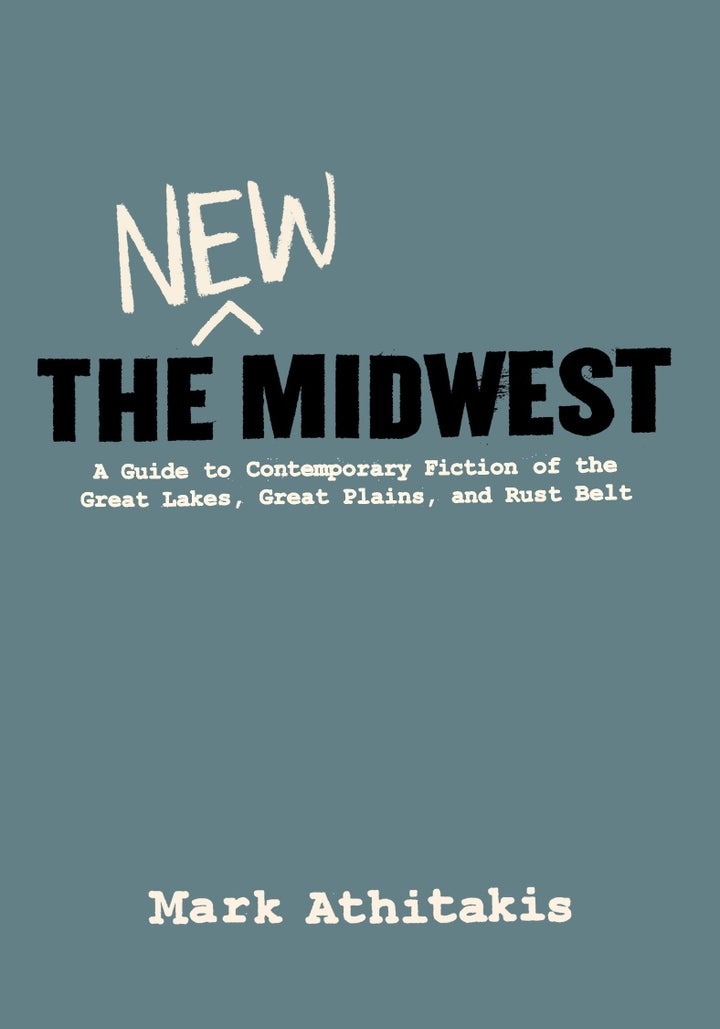
As the results of the 2016 presidential election trickled in on Nov. 8, 2016, all eyes were suddenly glued to the center of the electoral map: Ohio, Michigan, Iowa, Wisconsin ― Midwestern states that had previously swung Democratic ― were looking likely to go for Republican candidate Donald Trump. And they did (Michigan and Wisconsin by impossibly slim margins), allowing Trump to eke out a surprise victory.
Though the Midwestern states typically enjoy attention during presidential elections, this unexpected outcome has sparked a lasting fascination among liberals and pundits who can’t understand how they got it so wrong. What’s really going on in the middle of the country?
To writer and critic Mark Athitakis, it’s not so difficult to understand ― at least if you’ve been paying attention. His slim new book, The New Midwest: A Guide to Contemporary Fiction of the Great Lakes, Great Plains, and Rust Belt, dives deep into Midwestern literature, unpacking the mythology of the region and how today’s writers are complicating our simple idea of the Heartland. “There are some things that make [the Midwest] specific and some things that make it unique,” he told The Huffington Post in a phone interview, “but I think it would be helpful if we got past this conversation ... that everybody in the Midwest is all this one way.”
For those who have been reading the great Midwestern fiction of recent years ― Marilynne Robinson’s Iowa novels, Jonathan Franzen’s The Corrections, Angela Flournoy’s The Turner House, Celeste Ng’s Everything I Never Told You, and even out-of-print works like Divine Days by Leon Forrest and On Wings of Song by Thomas M. Disch ― it’s clear that the region is more than a cesspool of white resentment, but also more than a simple place full of homespun virtue and redemptive hard work. Athitakis parses how the best Midwestern fiction punctures the region’s superficially comforting image and re-examines its past to uncover a less idyllic, more troubled history.
HuffPost spoke to Athitakis about The New Midwest, what we can learn about the Midwest from its great fictional chroniclers, and why it matters:

You write that you don’t really find it helpful to talk about the fiction of the Midwest as a piece, all together, and you break it out into different themes. Which to me raises the question: What even inspired you to write a book about Midwestern fiction if you don’t see it as a cohesive whole?
I think I wanted to unsettle the canon of Midwestern literature as we understood it. Even today, people will say, “Oh, Midwestern literature, of course that’s Ernest Hemingway, Willa Cather, Saul Bellow, Nelson Algren.” I felt that’s one, two, maybe three generations past. What I was hoping to do here is raise some of these complications.
You’re absolutely right that there’s not a monolithic Midwest. There’s an urban Midwest, there’s a white Midwest, there’s a black Midwest, there’s a Hispanic Midwest. There’s various class strata in the Midwest. What I wanted to do was [...] take a look at some of these themes that seem to kind of adhere to the Midwest ― that it’s the region of hardworking immigrants, that it’s the region of sturdy families, it’s a region of farmlands, or even just in terms of the novel, that it is a place of the very four-square, conventional novel. And I thought that was a good framing device. Let’s take a look at the books that challenge those ideas of what the Midwestern novel is.
So for instance, when I was thinking about religion, obviously Marilynne Robinson is an important writer on that front. One thing that gets short shrift, I think, when a lot of critics write about Marilynne Robinson ― there is this reflex to say, “Oh, it’s about Iowa and it’s about religion,” and that there’s something sort of comforting about the way that she writes about faith. But these are kind of difficult books that deal with institutional racism and fractures within these Iowa communities.
I don’t write much about Garrison Keillor, I think I only mention him in passing. But he’s maybe the most obvious example of “here’s what the sturdy, folksy Midwestern culture is.” And I don’t have a lot of abiding anger toward Garrison Keillor. I think in some ways he’s a good writer and an interesting entertainer. But that’s not the kind of Midwest that is interesting to me.
You also note that much of today’s Midwestern fiction that you’re interested in is set in the past rather than contemporary. Why do you think that is? Do you think that has something to do with the idea of unsettling the mythology of the Midwest?
It’s hard to say without interviewing every single individual author, but I think there’s plainly an urge to try to look at this and recapture it and maybe try to salvage it from the folklore that has attached to it.
I would say that’s pretty plain if you read the “Last Hundred Years” trilogy that Jane Smiley has published over the last three years. These three big, sweeping novels, which start out as seeming like it’s just going to be a fairly polite tale about an Iowa farm family, but I think maybe the more ... maybe sinister is the wrong word, but the more complicated argument that Jane Smiley is making is that what happens in this small Iowa farm town is something that radiates to encompass a lot of things that have happened in American culture in the past 100 years.
I think maybe that there is this feeling among a lot of writers that the Midwest as it’s been presented doesn’t really adhere to what a lot of the reality is.
To the extent that these novels recently are really grappling with social justice issues like race, gender, gender identity, etc., do you think there’s a particular concern with how these social justice issues manifest in the region, or is it of a piece with a national trend to write about these topics?
I think there’s a few ways to answer that question. I think certainly you can’t talk about the Great Migration without talking about the Midwest. I think that’s plain.
I close the book with a longer essay about a novel called Divine Days by Leon Forrest, who is an African-American novelist. He had started his career writing experimental fiction about the South. Toni Morrison was his editor. His final big book was this 1200-page epic that encompasses a black family that had migrated up to Chicago from New Orleans, deals with the legacy of slavery, deals with the relationships between black and white. It is, in many ways, a celebration of Chicago’s South Side culture even while it criticizes some of the cultural elements of it, especially when it comes to religion. I would say that is something that is a uniquely Chicago story, and a uniquely Midwestern story.
I think also a book like Angela Flournoy’s The Turner House deals very explicitly with the relationship of the African-American community to Detroit, and what kind of responsibility does a city like Detroit have toward its citizens, especially once the community starts collapsing. She does an interesting job of paralleling the larger civic collapse that happens in Detroit with what’s crippling that family that she writes about, who are forced to take on different paths because they have the support system of a family, but they don’t have that larger superstructure looking out for them.
Another one: Celeste Ng’s Everything I Never Told You is an interesting look at what happens to an Asian-American family in Ohio in the 1970s, where they are treated as a foreign ... more of a curiosity, where I don’t think that would necessarily happen in a more pluralistic culture, say on the East Coast or the West Coast. So I think there are some unique aspects to the Midwest when it comes to that.
One book that I think didn’t get a lot of attention when it came out, and I think it’s an interesting example: Rachel Louise Snyder’s novel What We’ve Lost Is Nothing, which is set in Oak Park, Illinois, a Chicago suburb. Oak Park has become this long-running experiment in how you integrate a community. They have laws on the books that try to ensure black and white families live close to each other, because there are enough studies that show that integrated communities can be more successful, lower crime rates and that sort of thing. And she spotlights the sort of reflexive racism that still kicks in when events happen in this neighborhood.
It speaks to this perhaps stereotypically Midwestern spirit to try to enforce ways for different types and groups of people to get along, but also reveal some of the challenges connected to that.
I wanted to talk a little bit about the political aspect. I don’t know if you could have known, when you began writing this, how much the Midwest would have become the focus of political attention by now. What do you make of the conversations that have been had in the media and political circles about Midwestern voters recently and what needs to be done to speak to them?
I wrote the book pretty much in the first half of 2016, where Donald Trump was obviously a presence, but I think there was still a lot of wishful thinking going on that there really wasn’t going to be a lot of people voting en masse to make him the Republican nominee and the president. In some ways, I was as shocked as anybody, but once you saw how things broke down ... I’m not entirely shocked that this had happened, once I’d had a moment to think about it.
I did write a piece, “11 Works of Midwestern Fiction for the Trump Era.” Even though we’ve had eight years of Obama, we’ve had a long period, starting from the Rust Belt era in the ‘70s, where a lot of people who’ve been raised in manufacturing areas have been left behind and not a whole lot has been presented to them as opportunities to improve their status.
I don’t buy into the argument the Midwest is uniformly anything, but certainly not uniformly this hotbed of angry white racist resentment. I think there’s a pocket of that. If you even go back to read Joyce Carole Oates’s 1970 novel, Them, which is covering a lower-middle-class white family in Detroit, which does feel that sort of resentment about what’s going on in racial politics and feels very disassociated from it. So it certainly exists. I think there isn’t one reason that made the region go toward Trump, but I think there’s a variety of economic and cultural forces and long-standing frustrations that, perhaps if you read a little of the fiction of the region, wouldn’t come as so much of a surprise.
I don’t know if you saw, but President Obama gave an interview to The New York Times, and he talked about how much reading fiction helped him during his presidency, as a way to remind himself about broader truths. Do you think reading fiction about the Midwest is a really important way for politicians and citizens to connect with what’s going on in the country?
I think it certainly couldn’t hurt. I see these stories that come up every few months that say fiction helps improve our capacity for empathy, and part of me wants to say, even though I’m a book critic ― well, talking to people will do that as well! I think what we’re seeing here is we’re in an environment now where all of us need to develop our reflex for trying to understand where other people come from, or people who are different from our experiences, our economic backgrounds, our geographical backgrounds, our understanding of what politics means, our idea of what place means.
I think there’s a little more urgency to remove ourselves from our bubbles. Maybe one way to start the conversation is to say that the Midwest is not a monolithic place. There are some things that make it specific and some things that make it unique, but I think it would be helpful if we got past this conversation to say that everybody in the Midwest is all this one way. Perhaps the book can do a little bit to spotlight some of the diversity of the region.
Obama talked about the importance of stepping into somebody else’s shoes for a while, and I think that’s probably a very valuable thing to do these days.

